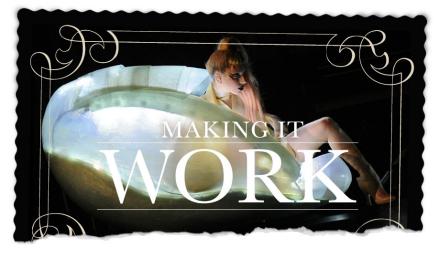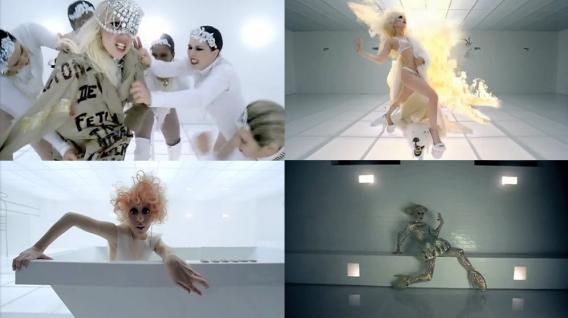Postcards From Camp
Can you make a career of camp?

Singer Lady Gaga by Mark Ralston/AFP/Getty Images
When we left off, I offered an image of camp as a kind of junkyard magnet that rescues discarded celebrities from the rubble so that they may be set upon pedestals and appreciated using a more empathetic set of criteria. But what if an artist decides to insert herself purposefully into that scrapheap? Can you throw yourself at the magnet and hope to stick? Can you make a successful career of camp?
This line of questioning is related to our earlier discussion about camp intentionality—that is, the issue of whether camp can be consciously cultivated in a given text. On that point, you’ll remember we determined that the best one can hope for is to prepare the way for camp, to create a film, novel, or other object that allows for a wide range of reception. But when it comes to stardom, one’s image is one’s text, and executives who finance movies and albums aren’t likely to support an image that is constructed solely with camp appeal in mind. Still, certain artists do seem to have actively made camp the defining mode of their careers. What, then, is the calculus that makes this worthwhile? And more importantly, does this “branded” camp count?
To get at the first question, we need to go for a ride.
During visits with my family back in South Carolina, I inevitably find myself in my college-age brother’s sports car. Before I can get in, though, little bro has to clear the passenger seat of dirty clothes, disc golf equipment, and empty sports drink bottles—he’s straight, and the nuances of personal organization sometimes escape him. But I treasure these rides. Driving down country roads, I find out what’s going on in my brother’s life and, for our purposes here, hear the kinds of music the kids are listening to these days. A few years ago, he plugged his iPod into the bass-heavy sound system, and Lady Gaga’s hit single “Just Dance” began to play. I immediately felt uncomfortable; this was a song that I had long associated with camp (not to mention general gayness, as the song was guaranteed to be on repeat at the bars I frequented at the time). However, here was my brother—the athletic, lady-killing, unshaved, quintessential dude—tapping his fingers to the music of an artist whom I understood almost entirely in terms of camp.
Obviously, my brother, while listening to exactly the same song, was hearing something completely different than I was; camping to him unquestionably involves tents. We were engaging with the same music in different ways, or rather, drawing different meaning from the same music. I timidly questioned my brother regarding his opinion of Lady Gaga, and he responded with some version of “oh yeah, she’s really hot.” This, I assure you, is not why I find Gaga interesting in the least. How to explain this divergence of reception?

Stills from Youtube
Could it be that Gaga is operating on at least two levels of interpretation, or “frequencies,” simultaneously: one relatively mainstream and one accessible to camp-attuned people? Since launching her persona in 2008, Gaga has aggressively accessorized her look with a range of discernibly queer signifiers like Warholian pop art, operatic melodrama, diva mythology, self-conscious commentary on fame, and gender play, but these are not entirely without purchase in the pop mainstream. Indeed, they read as some combination of campy (which, as we’ve already established, is a widely understood aesthetic style), provocative, and eccentric to anyone paying attention. But these same tropes join forces to make Gaga, as a text, extremely friendly to a camper. Just off the top of my head, I find camp in her weirdly huge eyes in the “Bad Romance” video, as well as in her cartoonish pronunciation of “ra-pa-pum-pum” in the lesser-known gem “Christmas Tree.” These are the reasons I’m attracted to Gaga, not because the music (or the person) is “hot”; but lucky for my brother and me, she can support both modes of attention.
The lesson to draw here is that skilled artists may make themselves, in a real sense, scholars of camp, using their well-honed knowledge of its mechanics to craft a compelling, engaging image, even if the appeal is limited to a small subset of fans. Gaga is not alone; Madonna tried a similar tack in her appropriation of the nuance-in-motion dance style called voguing. But Annie Lennox, who essentially presented a camp treatise in her 1992 Diva incarnation, was more erudite than each of them. Just watch the video for “Walking on Broken Glass”—it’s almost too academic. We have a Versailles-like setting (many have located in the French palace the beginnings of camp’s attention to detail), a zealous use of quick cuts featuring all manner of furtive glances and minuscule gradations of emotion, and, most crucially, a tight, spot-lit focus on Lennox’s wildly expressive eyes.
“Broken Glass,” like Lennox’s other camp etudes “No More I Love You’s” and “Little Bird,” place the self-styled camp diva in environments themselves overflowing with camp potential. But the question remains: Given that the camp fabric of these careers has been actively and painstakingly stitched together, does it count? True, these masterful tapestries may not be as thrilling as the stray fibers we can trace in, say, an oeuvre such as Whitney Houston’s, but I’m inclined to let them pass. Even though we can clearly see the machinery churning under the hoods of these stars, the fact that they are so damn good at channeling the camp spirit justifies their contrivance in my book. Camp, like any medium, needs its dedicated workers as much as it needs its idiot savants.
Then there’s the irony that while artists like Lennox and Gaga are broadcasting on different frequencies, they are also smuggling little snatches of an alternative ethos into the Top 40. In the final set of posts starting on Monday, we’ll consider what other gifts camp might have on offer when it sneaks up on the mainstream.
